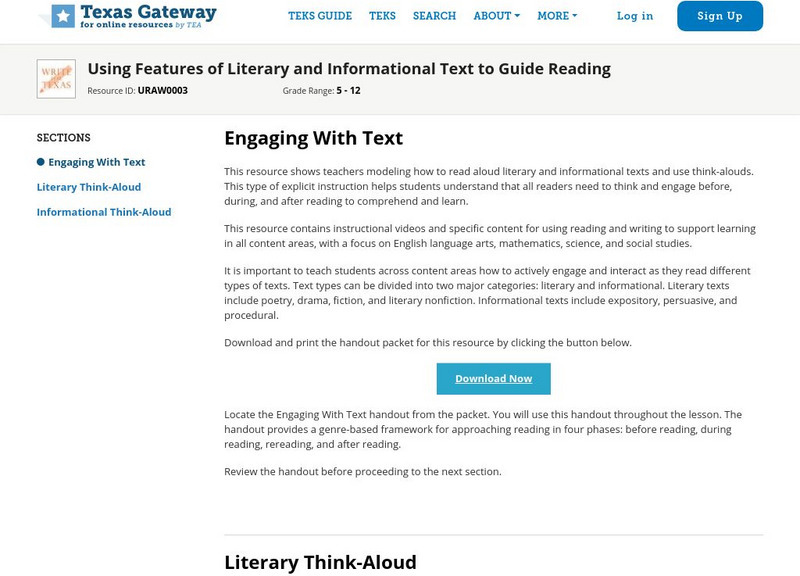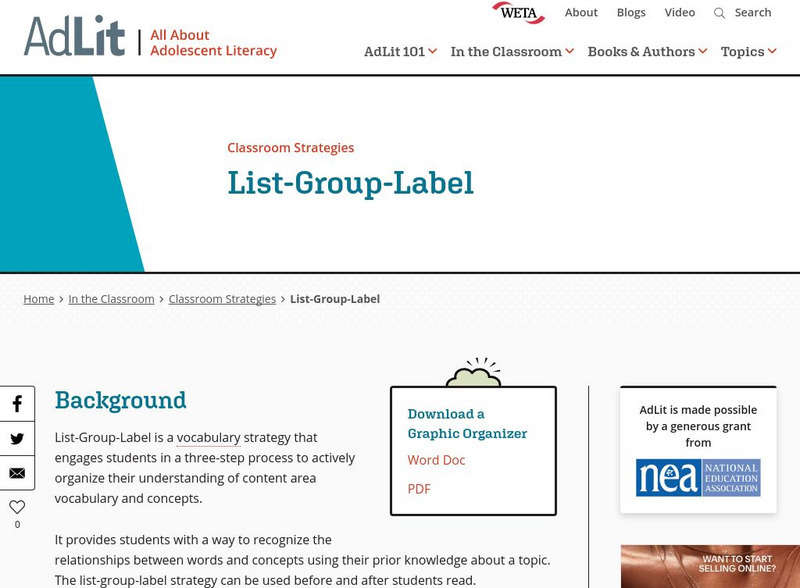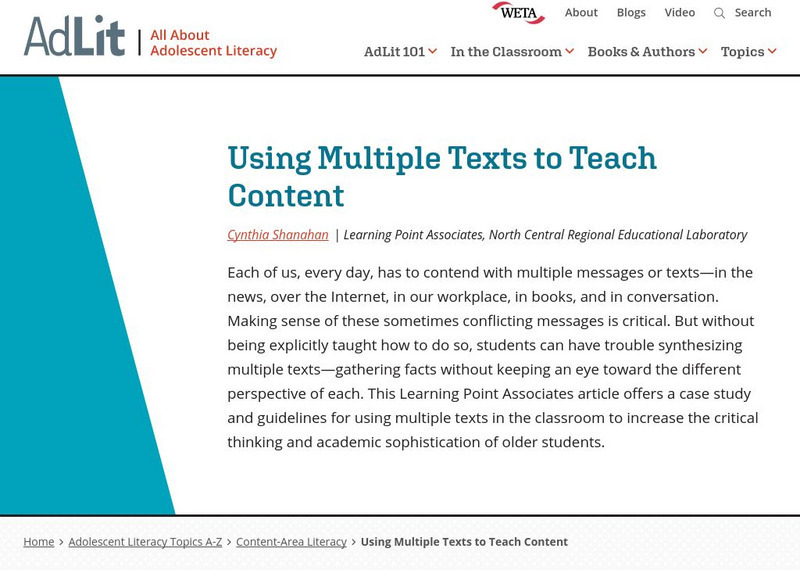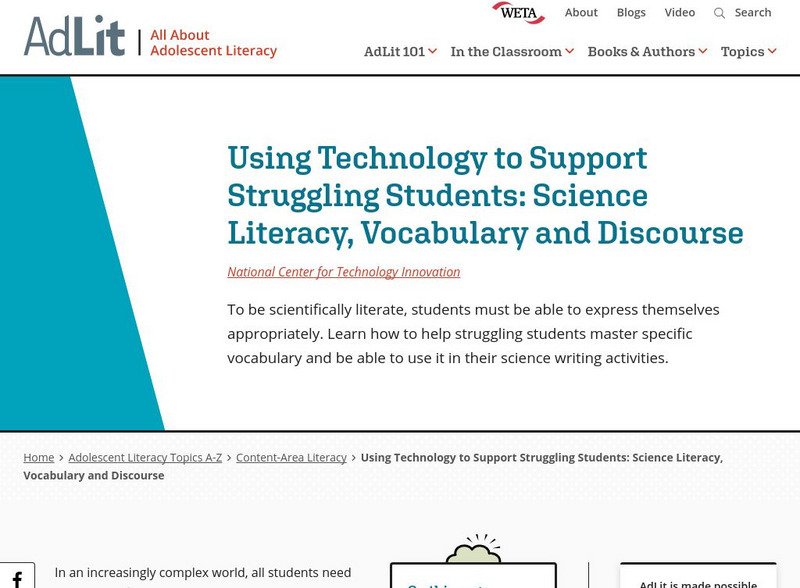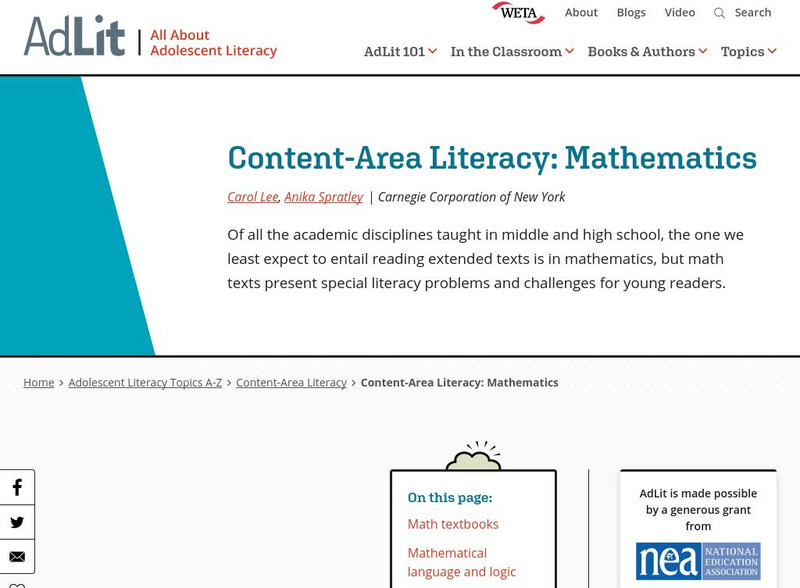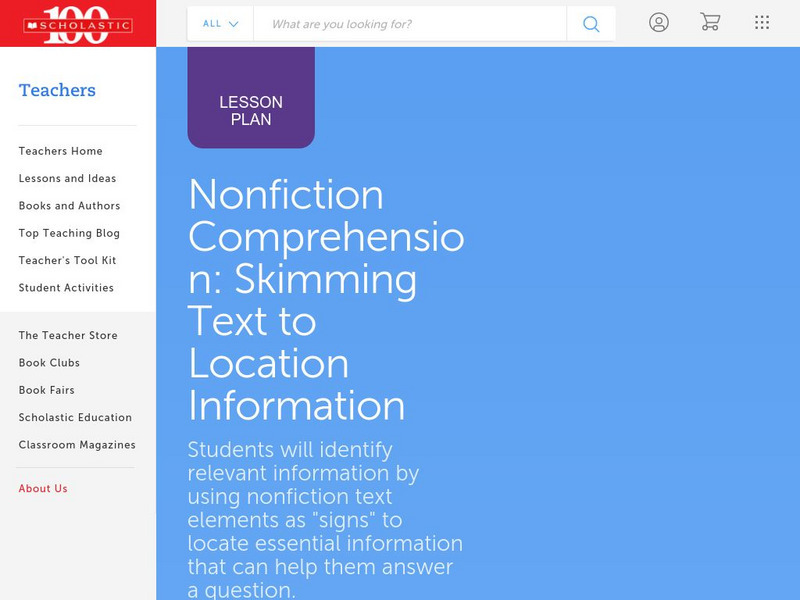City University of New York
Cuny: E Resource Center: Course Tutorials: Reading Your Textbook
A tutorial consisting of seven exercises showing different text structures used in textbooks. Learn how they organize information to help students locate specific details and how to take notes based on information within a textbook.
Texas Education Agency
Texas Gateway: Using Features of Literary & Informational Text to Guide Reading
A learning module that teaches students about using text features to guide reading in three mini lessons: Engaging with Text, Literary Think-Aloud, and Informational Think-Aloud. Download a PDF with lesson plans and printable handouts...
California State University
Reading Strategies From the University of Waterloo
Brief and easy to read, this California State University Northridge site lists strategies for getting the most of your reading. Geared for reading texts and technical material.
AdLit
Ad lit.org: Classroom Strategies: List Group Label
It provides students with a way to recognize the relationships between words and concepts using their prior knowledge about a topic. The list-group-label strategy can be used before and after students read.
AdLit
Ad lit.org: Use Easy Nonfiction to Build Background Knowledge
A Texas librarian shares his strategy of using nonfiction picture books to introduce new concepts to struggling adolescent readers and to build their background knowledge. Once students have been exposed to academic content in easy...
AdLit
Ad lit.org: Seven Strategies to Teach Students Text Comprehension
Comprehension strategies are conscious plans - sets of steps that good readers use to make sense of text. Comprehension strategy instruction helps students become purposeful, active readers who are in control of their own reading...
AdLit
Ad lit.org: Using Multiple Texts to Teach Content
Each of us, every day, has to contend with multiple messages or texts-in the news, over the Internet, in our workplace, in books, and in conversation. Making sense of these sometimes conflicting messages is critical. But without being...
AdLit
Ad lit.org: For Middle Schoolers: Activities to Build College Level Reading Skills
ACT has developed this list of activities to help middle-school students improve their reading ability. Parents and educators can use this information to help ensure that these students are on target for college and career readiness.
AdLit
Ad lit.org: Key Literacy Component: Text Comprehension
Text comprehension allows readers to extract or construct meaning from the written word. Students who misread words or misinterpret their meanings are at a disadvantage. Proper instruction can boost students' skills in this key area.
AdLit
Ad lit.org: Using Technology to Support Struggling Students: Vocabulary
To be scientifically literate, students must be able to express themselves appropriately. Learn how to help struggling students master specific vocabulary and be able to use it in their science writing activities.
AdLit
Ad lit.org: Content Area Literacy: Mathematics
Of all the academic disciplines taught in middle and high school, the one we least expect to entail reading extended texts is in mathematics, but math texts present special literacy problems and challenges for young readers.
AdLit
Ad lit.org: Assistive Technology Tools: Writing
Learn about assistive technology tools - from abbreviation expanders to word-recognition software programs - that address your child's specific writing difficulties.
AdLit
Ad lit.org: Assistive Technology Tools: Reading
Learn about assistive technology tools - from audiobooks to variable-speed tape recorders - that help students with reading.
AdLit
Ad lit.org: Adolescent Literacy: What's Technology Got to Do With It?
Learn how technology tools can support struggling students and those with learning disabilities to acquire background knowledge and vocabulary, improve their reading comprehension, and increase their motivation for learning.
AdLit
Ad lit.org: Key Literacy Component: Writing
Students who don't write well aren't able to learn and communicate effectively. This article explains what good writing skills are and how to help struggling young writers gain those skills through proper instruction.
Scholastic
Scholastic: Lesson Plan for Nonfiction Comprehension: Skimming Text
Build comprehension by developing reading strategies for use with nonfiction text. This lesson focuses on teaching students to recognize text elements as clues to help them quickly locate key information in text.
Writing Fix
Writing Fix: Writing Scientific "Recipes"
Adapted from a lesson in the book 51 Wacky We-Search Reports by Barry Lane, this lesson asks students to read several recipes to gain an understanding of how they are written and the types of words they use. Then students demonstrate...
E Reading Worksheets
E Reading Worksheets: Genre Worksheets
This learning module provides remediation with identifying genre of books and various texts. Practice with capitalizing nouns is provided with through worksheets, an online site, and a video tutorial. .
E Reading Worksheets
E Reading Worksheets: Genre Activities
This learning module features "genre" as the topic for PowerPoint presentations, lessons, and quizzes. Numerous projects with the "genre" theme are available for further exploration as opportunities for more in-depth investigations.
Polk Brothers Foundation Center for Urban Education at DePaul University
De Paul University: Center for Urban Education: Nonfiction Reading Strategy Assessment [Pdf]
This inventory provides questions to determine the habits that students use when reading nonfiction pieces. This inventory may be used at the beginning of the year or prior to beginning a unit that involves the reading of nonfiction texts.
Other
Text Help: Middle Grades Informational Text [Pdf]
A useful resource with ideas for teachers to meet the Common Core Standard 8.3 for informational text. The ideas are designed for use with the program Read and Write Gold, but could be implemented on paper.
Other
Kid Bibs: Effective Use of Textbook Features
Here, parents and teachers can find tips for helping young readers understand the expository writing found in textbooks.
ReadWriteThink
Read Write Think: Nonfiction Pyramid
A printable pyramid for use with nonfiction texts while students identify the main ideas and supporting details within a text. Students also determine author's purpose and key vocabulary words. Directions on how to use this type of...
ReadWriteThink
Read Write Think: Exploring Reading Strategies
This lesson plan explores reading strategies by creating a musical soundtrack to accompany the specific reading. Included in the lesson plan is an overview, practice, objectives, resources, preparation, and more.



